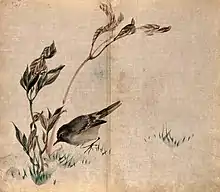Pecking
Pecking is the action of a bird using their beak to search for food or otherwise investigate an object or area by tapping it. Pecking can also be used by a bird to attack or fight another bird.

Pecking is frequently observed in chickens and other poultry, and in pigeons.[1] Pecking is typically accomplished by movement of the neck.[1]
Certain birds, particularly woodpeckers, engage in a specialized kind of pecking, using their beak to drill holes in trees in order to find insects under the bark. Woodpeckers also engage in a kind of pecking called drumming, a less-forceful type of pecking that serves to establish territory and attract mates.[2] Woodpeckers drum on various reverberatory structures on buildings such as gutters, downspouts, chimneys, vents and aluminium sheeting.[3]
The phrase, pecking order, referring to the hierarchical system of social organization was coined by Thorleif Schjelderup-Ebbe in 1921,[4] in reference to the expression of dominance in chickens by behaviors including pecking. Schjelderup-Ebbe noted in his 1924 German-language article that "defense and aggression in the hen is accomplished with the beak".[5] This emphasis on pecking led many subsequent studies on fowl behaviour to use it as a primary observation, however, it has been noted that roosters tend to leap and use their claws in conflicts.[6]
References
- Harris Philip Zeigler, Ralf Jäger, and Adrian G. Palacios, "Sensorimotor mechanisms and pecking in the pigeon", in Harris Philip Zeigler and Hans-Joachim Bischof, Vision, Brain, and Behavior in Birds (1993), p. 265.
- "Stopping Woodpecker Damage". Joy of Birds. March 22, 2018. Retrieved April 27, 2018.
- "Three Reasons Why Woodpeckers Drill Holes on Houses". Woodpeckers. Cornell Lab of Ornithology. 2002. Retrieved 6 July 2017.
- Perrin, P.G., (1955). Pecking order 1927-54. American Speech, 30(4): 265-268
- Schjelderup-Ebbe, 1975 p. 36 cited in Rajecki, D.W. (1988)
- Rajecki, D.W. (1988). Formation of leap orders in pairs of male domestic chickens. Aggressive Behavior, 14(6): 425-436